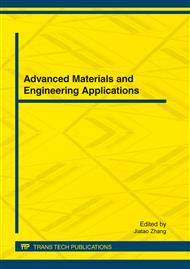[1]
K. Tanabe , T. Takebe , M. Isozaki , Reduction of Audible Noise Using Asymmetrical Bundles for 1000KVTransmission Lines: Full-scale Test Results of Akagi Test Line , J. Transactions on Power Delivery.11(1996) 1482-1488
DOI: 10.1109/61.517507
Google Scholar
[2]
K. Miyajima , K. Tanabe. Evaluation of Audible Noise from Surface Processing Conductors for AC Overhead Transmission Line , J. Electrical Engineering in Japan. 159(2007) 415-420
DOI: 10.1002/eej.20509
Google Scholar
[3]
K. Tanabe. Hum Noise Performance of 6 , 8 , 10 Conductor Bundles for 1,000kV Transmission Lines at the Akagi Test Site: A CoMParative Study with Cage Data , J. Transactions on Power Delivery.6(1991)1979-1982
DOI: 10.1109/61.97724
Google Scholar
[4]
H. Choi, E.Stathatos, D. D. Dionysioua. Photocatalytic TiO2 films and membranes for the development of efficient wastewater treatment and reuse systems,J. Desalination . 202 (2007)199–206
DOI: 10.1016/j.desal.2005.12.055
Google Scholar
[5]
J.D. Louis, I. N . Mermilliod, G. Boiron, S. Staveris. Improvement of Polypropylene Film Adhesion in Multilayers by Various Chemical Surface Modifications [J].International Journal of Adhesion and Adhesives. 15(1995) 205-210.
DOI: 10.1016/0143-7496(96)83700-6
Google Scholar
[6]
K.S. Hwang , B.A. Kang , S.D. Kim, S. Hwangbo, J.T. Kim. Amorphous vanadium pentoxide thin films prepared by electrostatic spraying-pyrolysis deposition, J. Ceramics International, 38S (2012) S645–S647.
DOI: 10.1016/j.ceramint.2011.05.117
Google Scholar
[7]
Q. J. Ning, T.H. Zhang , X. L. Hu. Preparation of hydrophilic TiO2-SiO2 thin films by sol-gel method, J. Transactions of Materials and Heat Treatment. 28(2007)42~45.
Google Scholar
[8]
S Tang, N .M.Lu, S.W .Yung, H.S. Choi. Enhancement of Adhesion Strength Between Two AISI 316 L Stainless Steel Plates Through Atmospheric Pressure Plasma Treatment , J. Surfaceand Coatings Technology. 200(2006):5220-5228.
DOI: 10.1016/j.surfcoat.2005.06.020
Google Scholar
[9]
G. Grundmeier, M .Stratmann. Plasma Polymerisation - A New and Promising Way for the Corrosion Protection of Stee, J. Materials and Corrosion. 49(1998)150-160.
DOI: 10.1002/(sici)1521-4176(199803)49:3<150::aid-maco150>3.0.co;2-x
Google Scholar


